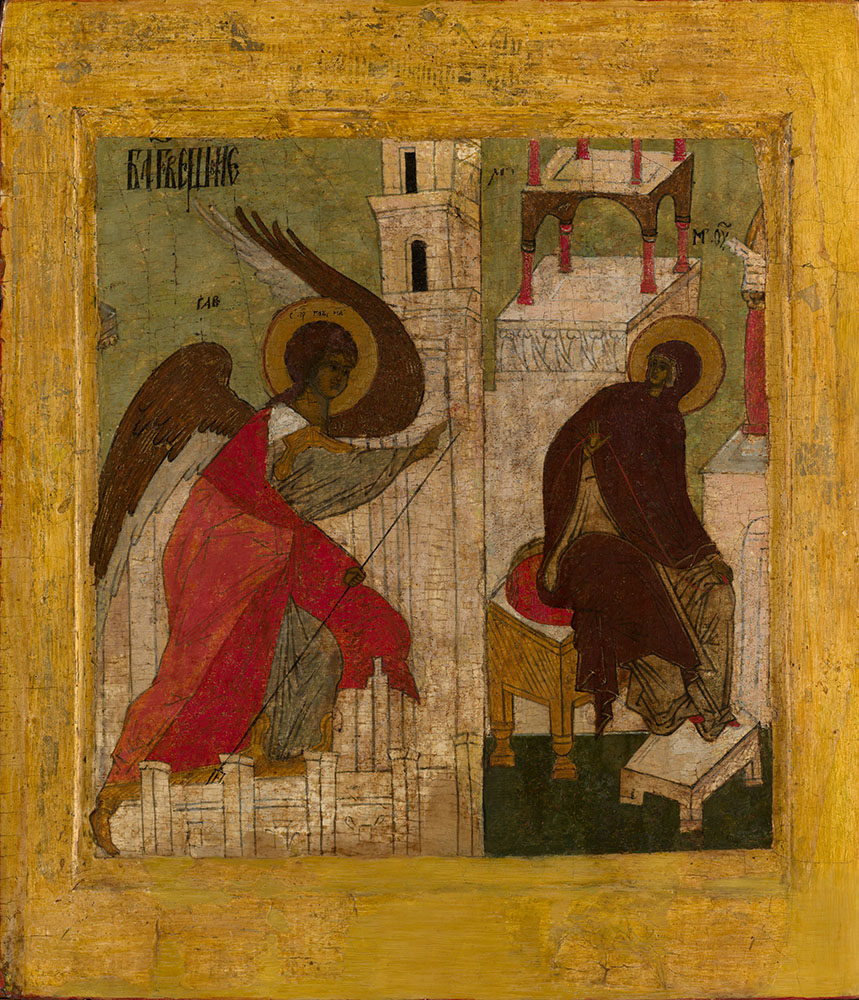MacDougall Auctions 2-3 December 2009
2 December 2009

* 7. THE ANNUNCIATION
ROSTOV, FIRST THIRD OF THE 16TH CENTURY, INSERT (VRESOK)
46.5 by 39.7 cm.
50,000-70,000 pounds
This icon is a fragment from the finial parts of the Royal Doors, made of two folds cut out from older panels, then joined together and inserted into one new panel. Such “restoration” of ancient paintings is usually associated with the Old Believers’ attempts to carefully preserve the fragments of damaged icons.
The iconography of the scene references the Royal Doors of the Trinity Cathedral from the Troitse-Sergieva Lavra (Trinity Monastery of St Sergius), produced in 1425-27. Many details of that painting are closely imitated in the present image: the half-turned posture of the enthroned Virgin, the swift tread of Archangel Gabriel, the positioning of his wings and the dynamically advancing folds of his vermilion cloak. Many unusual details also coincide, such as the motif of the crenellated wall of the enclosed garden, through which the archangel crosses to bring the glad tidings, and the regal appearance of his vestments, with pearl-embroidered sleeves of his chiton. The architectural features are very distinctive and originally found on the Royal Doors of the Trinity Cathedral; it is therefore clear that the present image was modeled on their iconographic derivatives. At the same time, many details (symbolically significant for the 15th century, yet less important for the art of the later period) have been omitted from this image.
The artistic features of this fragment also demonstrate that its maker was influenced by the works produced in the Moscow and Rostov schools of icon-painting. The light-green
background, typical for the first third of the 16th century, and the smooth streamlined silhouettes of the almost bodiless figures, dressed in wide flowing drapery, confirm
the date of the icon as the early decades of the 1500s. The painting style of the faces with soft modelling and colouristic combination of warm shades of brown, red, light grey-blue, and pink are all characteristic of the central Russian (particularly Rostov) icon-painting tradition. The uniquely precise and unusually detailed draftsmanship, seen under the semi-transparent painting, plays an important part in making the icon an artistic whole. The elegant calligraphy of the master characterises him as a remarkable professional who freely positions the figures within the icon field, rendering their postures lively and expressive, their gestures precise. The cascades of the drapery and the edges of the descending folds are particularly complex and beautiful, with no known analogs among the works of the first third of the 16th century.
Despite a significant number of restorations, renovations and additions, the icon doubtlessly holds a particular artistic importance and contributes to our understanding of the style of the icons produced in Rostov in the early decades of the 16th century, very few of which have survived to the present date.
Notes on symbols:
* Indicates 5% Import Duty Charge applies.
Ω Indicates 20% Import Duty Charge applies.
§ Indicates Artist's Resale Right applies.
† Indicates Standard VAT scheme applies, and the rate of 20% VAT will be charged on both hammer price and premium.